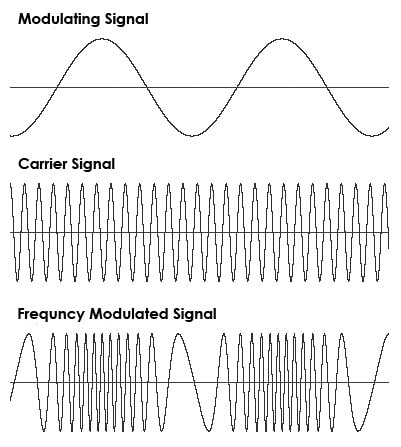In the communication system, messages or information are sent using electrical signals. The raw message is converted into electrical signals using a transducer. These electrical signals are used to carry the information from source to destination. In baseband communication signals with enough power can be transmitted without any modulation. But in the case of long-distance communication or wireless communication, modulation is necessary to reduce the size of the antenna and for efficient transmission of signals.
Modulation is a process in which the message signal (electrical signal) is superimposed on a signal with high frequency. The signal on which the modulation is being performed is called modulating signal. The high-frequency signal using which modulation is performed is called the carrier signal. The signal we get after modulation is called modulated signal. In analog communication, three modulation schemes are used – Amplitude Modulation (AM), Frequency Modulation (FM), and Phase Modulation (PM). In this article, we are going to discuss the difference between AM and FM.
Difference between AM and FM in tabular form
In the following table, we are going to discuss the differences between AM and FM.
| AM | FM |
| It stands for Amplitude modulation | It stands for Frequency modulation |
| The amplitude of the carrier signal is varied with respect to the amplitude of the message signal. | The frequency of the carrier signal is varied with respect to the amplitude of the message signal. |
| The frequency and the phase of the carrier signal remain unchanged. | Amplitude and the phase of the carrier signal remain unchanged. |
| In AM, noise is also amplified along with the signal. So it is more affected by noise. | FM signals are more immune to noise and the effect of noise can be further reduced. |
| The bandwidth required for amplitude modulated signal is more than FM signals. | The bandwidth required for frequency modulated signal is more than AM signals. |
| Amplitude modulation requires simple and low-cost circuitry for both modulation and demodulation. | Frequency modulation is a more complex process and requires complex and costly devices for modulation and demodulation. |
| In the case of AM, a sufficient part of the transmitted power gets wasted, thus efficiency decreases. | In the case of FM, all the power transmitted is used, hence the efficiency is high. |
| AM broadcasting like VHF aircraft radios, video transmission in TV, etc. | FM broadcasting like the audio transmission in TV |
What is Amplitude Modulation?
If the amplitude of the carrier signal changes with respect to the amplitude of the modulating signal then the modulation scheme is called amplitude modulation or AM. In this scheme of modulation, the modulated signal is a high-frequency signal which is shaped like an envelope whose amplitude depends on modulating signal. It will be easier to understand AM if we look at the image below.

Let us discuss the mathematics behind AM. Let the modulating signal be m(t) and the carrier signal is c(t) = Acos(ωct) where A is the amplitude of the carrier signal and ωc is the angular frequency of the carrier signal.
Now the modulated signal will be –
mAM(t) = [A + m(t)]cos(ωct)
This is the result in the time domain. In the frequency domain, we get –
MAM(ω) = 0.5[M(ω + ωc) + M(ω – ωc)] + πA[δ(ω + ωc) + δ(ω – ωc)] [Where M(ω) is the frequency domain response of m(t)]
In general AM mAM(t) = m(t)cos(ωct). In frequency domain we get – MAM(ω) = 0.5[M(ω + ωc) + M(ω – ωc)]. Hence, in the case of general AM, in the frequency domain, we get two sidebands centered at the carrier frequency, ωc. This is why general AM is called Double Side Band AM or DSB-AM.
In the case of AM the noise also gets amplified so the quality of the received signal reduces. To increase the signal-to-noise ratio by a factor of N we also need to increase the signal power by a factor of N. In the case of DSB AM some of the power gets wasted due to the double sideband. This is why there is also another AM scheme called SSB or Single Side Band AM.
Amplitude modulation was one of the earliest modulation schemes. This is used in communication in AM broadcasting such as AM radios, VHF aircraft radios, etc.
What is Frequency Modulation?
If the frequency of the carrier signal changes with respect to the amplitude of the modulating signal then the modulation scheme is called frequency modulation or FM. In this scheme of modulation, the modulated signal is a variable frequency signal whose frequency changes with the amplitude of the modulating signal. It will be easier to understand FM if we look at the image below.

A frequency-modulated signal can be expressed as
\[m_{FM}(t)=A\cos [\omega _{c}t + K_{f}\int_{-\infty }^{t}m(a)\; da]\]
Where ωc is the carrier frequency and Kf is a constant and m(t) is the modulating signal.
In FM, noise is not amplified along with the signal, so, the effect of noise can be removed. Also, the power transmitted in FM is used completely so the efficiency is high.
FM signals are very popular in the communication system. This is used in FM broadcasting such as FM radios (which are very common), the audio transmission of television, etc.
Conclusion
Though FM is more common and has more advantages than AM, in the modern communication system, both AM and FM schemes are used side-by-side.
Author
Subhrajyoti Choudhury
University of Calcutta, Kolkata
